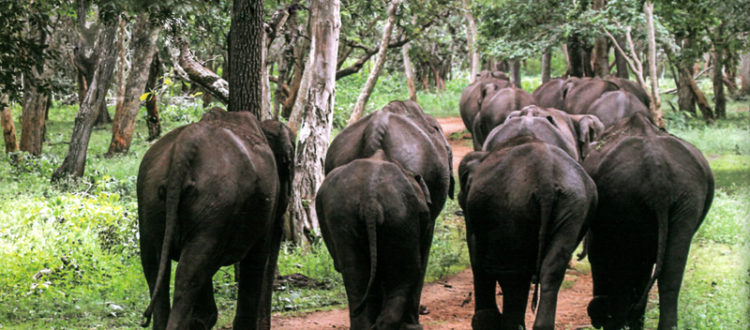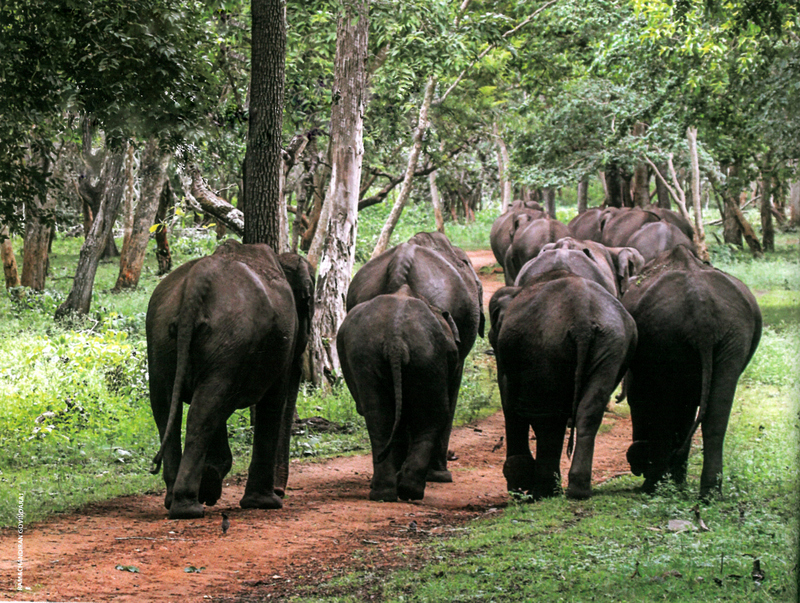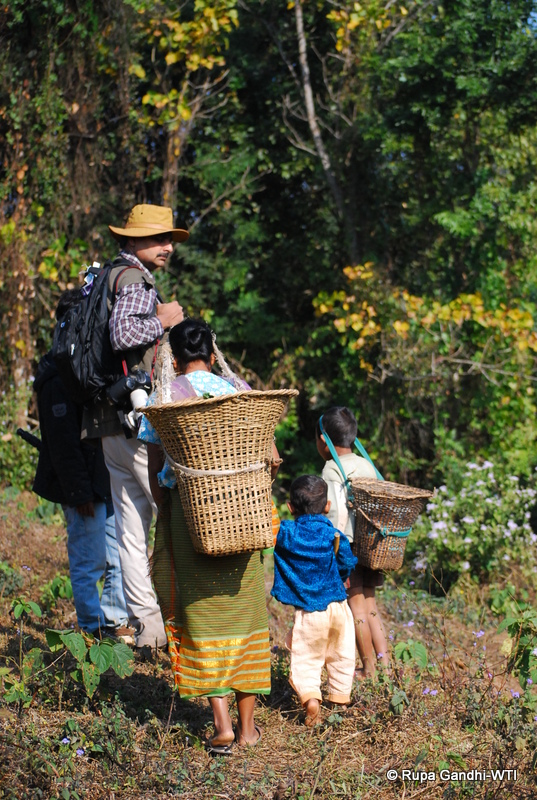30
Nov
Travelling Wild
0 Comment
Elephants use a forest path in Nagarhole, which was once under the repeated assault of the infamous bandit Veerapan, who massacred the pachyderms for ivory
When was the last time that you truly travelled wild? Left the mundane road and chose the untrammelled dirt tracks of a wilderness, wind in the hair, rain in the face, snow on the boots and a feeling of indescribable lightness in the heart?
One would expect those who have chosen a life in wildlife conservation to rattle off a dozen instances without blinking. And yet, as the field of conservation becomes a settled business of office dealings and resort-based excursions, even the hardcore wildlife biologist is turned into a soft yuppie, choosing an air conditioned room over a bivouac, a clean loo over the Capparis bush yonder, and the ubiquitous 4×4 over a trek through the jungle.
I confess that I have fallen partially into this trap. Even now, as I write this, I sit on the balcony of a five star hotel overlooking the Arabian Gulf with three days of an international conference to look forward to for networking. Yet tomorrow I shall sneak out to take a walk in a nearby reserve for half a day. In doing so I will probably miss two sessions of wonderfully constructed and well articulated presentations with a powerful PowerPoint message that overshadows the fact that much of what is being talked about has been the same for over two decades.
Vivek Menon walks the gibbon trail with Garo tribals in Selbalgre, Meghalaya
I prefer my déjà vu in the wild, so that a bird call can take me back several years to a similar encounter, or a vista can take me to another continent and a similar landscape. Unfortunately, being in the wild nowadays is also bound to yield a view of destruction that takes you back to another place, another time and another senseless deed. On the whole, though, it leaves you with scores of anecdotes which, if recorded in the mind’s eye, serve you well when the PowerPoint does fail, and which if strung together open up a line of thought that could be novel. After all, the plural of anecdote should be data, and not merely a fisherman’s tale!
Let me reminisce then of three such travels that I undertook, which yielded in equal measure creature discomforts, spiritual bliss and conservation truths. I do this in the hope that today’s crop of conservationists turn away from prolonged indoor meets and learn to travel wild – in the old, uncomfortable ways.
Let me reminisce then of three such travels that I undertook, which yielded in equal measure creature discomforts, spiritual bliss and conservation truths. I do this in the hope that today’s crop of conservationists turn away from prolonged indoor meets and learn to travel wild – in the old, uncomfortable ways.
A BANDIT AND A BOUNDARY
Let’s start in my genetic homeland, the south of India where I spent two weeks one muggy summer of the 90s tracking the infamous brigand Veerappan – or to be more precise, following the bloody trail of poached elephants he had left in his wake.
From Bhawanisagar to Gopinatham to the wonderfully sylvan Thengumarahada. From Kollegala to the holy forest shrine of Bannari Ammal to the forests of Coimbatore. Nothing unique in the places but what was special was that we travelled, three musketeers, on foot and on coracle (a round-bottomed boat that is typical of the region), never once using a motor vehicle. We wore lungis with a cotton vest for we had left our shirts behind, and carried only a fish hook, a bag of rice, pulses, some salt and oil. We could take no chance of the notorious brigand learning of our travels in advance and laying a trap for us. He had by then beheaded a prominent forest officer and kidnapped scores of others, and had killed policemen, forest officers and elephants with equal abandon. The only way to travel in his land was to move lightly, quickly and peripatetically with no fixed plans, baggage or transport – the fixed intent only being to tally his elephant victims.
We counted over 20 carcasses in the two weeks, and left only when a smaller but equally deadly rival, dubbed Baby Veerappan, got to know of our movements. But I had unearthed what forest officials had been unable to in years: evidence of Veerappan’s activities in the region. The feel of the Ziziphus thorns that we seemed to be perennially walking through when looking at elephant carcasses, the sweet flow of the Bhawani and the taste of Kaliappan’s fish still remain within me.
Eastward ho and to Burma (now Myanmar), where co-walker Surendra Varma and I spent weeks tramping the Arakan (now Rakhine) Yoma establishing the boundaries of Myanmar’s first elephant reserve. Little girls, their faces painted fresh with yellow paste, a local cosmetic, would come and peer at us: two strange, tall giants in this gentle land of swaying palms and rice fields. We walked more than 30 km. a day to mark the boundaries of the park. When we took a break from elephants, we floated days on end on boats down the Irrawaddy, basking in the sun and smoking cheroots, discussing conservation endlessly, looking for dolphins and talking to monks when we stopped at monasteries to sleep in. I did not see a single wild elephant or dolphin on the whole trip, but what a fabulous feeling to have played a part (no doubt minor) in establishing a new reserve and writing an action plan for the country!
ACROBATICS OVER AFRICA
Westward now and to Africa where I was with my boyhood hero Iain Douglas Hamilton, flying for days on end in his infamous small plane, counting elephants. And no, this was not the Mara where the world goes to see East African wildlife but around Lake Turkana on the Somalian border. The origin of man was somewhere below us, tightly bunched animals coursed the plains around, and the three of us (there was a biologist in the back) flew sortie after sortie, photographing and estimating animals below us. Resting under whatever little shade the acacias provided us, eating nyama choma and ugali, our small team counted a few thousand elephants in 10 days.
In between, Iain dove and careened the plane causing most other team members to retire sick, but what was to stop the world’s most celebrated field biologist to have his moment watching the one elephant that he wanted to look at amongst the herd? Not even the fact that we were 3,000 m. up in the air!
Three trips, three teams, three countries, different modes of travel, but one thread that binds these memories: travelling wild. For those bitten by the wild bug the adrenaline of such trips cannot be matched by any degree of creature comfort. And those in whose veins such a hormone fails to flow might as well abandon the pursuit of conservation and take to studying the genetics of snow peas in a laboratory attached to an urban university.
There is nothing, I assure you, that I have against those who do this; they serve a very important purpose as well. But they belong to a different sub species than I. And I hope generations of younger conservationists are produced from my own self selected genetic proclivity – that of the naturalist in the wild.
By:- Vivek Menon, Conservationist, Writer, Photographer, Executive Director, Wildlife Trust of India.
“First Published in Sanctuary Asia Vol. XXXV No. 10. October 2015”











